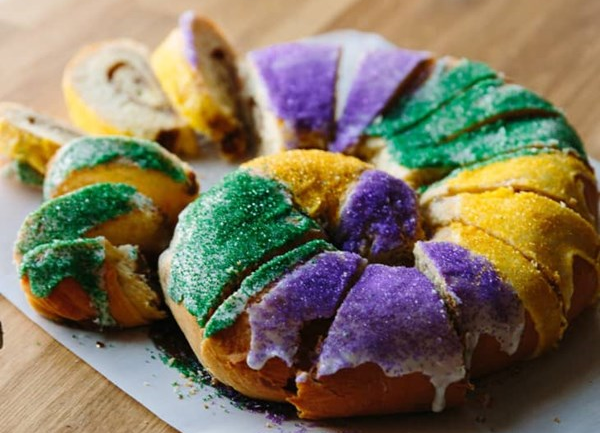How king cake inspires community
March 4, 2025 by DarcieToday Mardi Gras ended in New Orleans with the Fat Tuesday parade. One of the parade’s most well-known features is that participants throw items to the crowds along the parade route. These range from strings of purple, gold, and green beads to stuffed animals to (inexplicably) toilet plungers, and this year, a new item: a cookbook. A dance group called Krewe da Bhan Gras that has been performing bhangra, Bollywood and other South Asian dances in parades for the last three years, is handing out a cookbook of beloved South Asian dishes.

Another prominent feature of Mardi Gras and Shrove Tuesday celebrations is the king cake and its French cousin, the galette des rois. Eater’s Kayla Stewart explores the role of king cake in building communities around the world. Both king cake and galette des rois stem from centuries-old religious traditions that incorporated parts of even older pagan celebrations like Saturnalia. A hidden trinket inside both cakes symbolizes being the “king” and bestows good luck on whoever receives the piece with the trinket inside.
Even more important than the trinket is the sense of community that the cakes inspire. Pati Jinich says that in Mexico, the king cake, known there as rosca de reyes, “is a unifying treat, no matter who you are, where you stand politically, where you live — north or south.” New Orleans pastry chef Kaitlin Guerin agrees, saying “We all need something to remind us of why it’s important that we come together. The history of the cake is centered around community.” She recently added West African grains of paradise spice to the king cake, noting that adding the ingredient “comes from the questions I find I ask myself: As I’m connecting the bridge between the natural ingredients here in Louisiana to the continent, how would my ancestors have approached this bread?”
Categories
- All Posts (7144)
- Antipasto (2236)
- Author Articles (253)
- Book News (948)
- Cookbook Giveaways (1003)
- Cookbook Lovers (265)
- Cooking Tips (118)
- Culinary News (301)
- Food Biz People (561)
- Food Online (805)
- Holidays & Celebrations (280)
- New Cookbooks (156)
- Recipes (1531)
- Shelf Life With Susie (231)
- What's New on EYB (138)
Archives
Latest Comments
- Meredythhaas on Persiana Easy – Cookbook Giveaway
- demomcook on TL;DR
- dmass on TL;DR
- Indio32 on TL;DR
- MollyDT on A love letter to Sift by Nicola Lamb with a giveaway
- colleenmv on Pull Up a Chair – Cookbook Giveaway
- colleenmv on So Easy So Good Cookbook Giveaway
- colleenmv on The Salad Lab Cookbook Giveaway
- colleenmv on A love letter to Sift by Nicola Lamb with a giveaway
- colleenmv on Potluck Desserts Giveaway, Quick Bites and Recipes